I'm gifted in one area: sweating, so - in the name of science - I took to a heat chamber with a pro rider
Could his heavy sweating be the reason Steve Shrubsall will never win a Tour de France stage? The heat chamber may hold the answers...
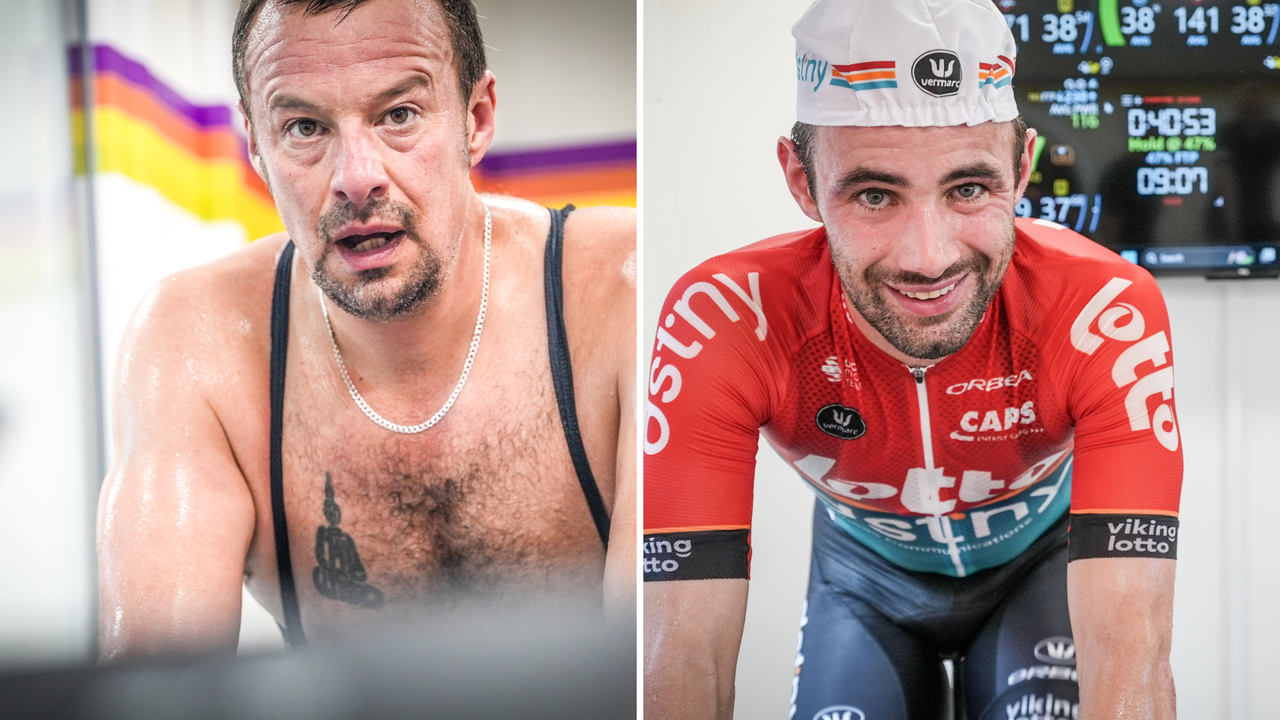
Be they hidden, untapped or in plain sight, we all have talents. Some have athletic ability, others have artistic flair. I don’t have either of these, but, I’m an incredibly gifted sweater. Yes, I leak in great gushing rivulets at the mere sight of a static cycle – show me 300 watts for 20 minutes and I’ll show you a very damp floor indeed.
I’d had my sweat rate - put simply, the amount of water lost through sweat - tested before; I was provided with some wildly inconsistent readings. So, when the team at UK-based Precision Fuel and Hydration contacted me with an opportunity to not only test my sweat and sodium losses in their new heat chamber, but to do so in the company of two Tour de France stage winners – Victor Campanearts and Jan Bakelants – I dug out my best base layer and made a beeline for their headquarters.
I arrived armed with queries. Firstly, I wanted to know how much sodium I was losing per litre of sweat. Keeping sodium balanced over long rides is key to optimizing performance, and being a rider who indulges in the occasional ultra distance escapade I wanted to ascertain just how liberal my body was with the salt shaker.
Secondly, and this is where the heat chamber would work its magic, how much sweat was I losing per hour? If it was as much as I thought, why was I losing such a significant amount of water, and perhaps most importantly, are such large losses detrimental to athletic performance?
Thirdly, how would I compare in terms of sweat and sodium losses to two cyclists who have reached the absolute peak of the sport?
Testing times
It wasn’t long before my first question was answered. Precision Fuel and Hydration have a fast and accurate means of testing for sodium losses which is carried out at rest. A small patch of skin on your forearm is stimulated by a device which emits a very light electric current in order to elicit sweat.
There was a slight, barely noticeable, tingling sensation throughout the test. “What sort of losses are you expecting?” asked sports scientist Emily Arrell while removing the device from my forearm. With lows in the region of 300mg per litre of sweat and highs all the way up to 2,000mg and beyond, I thought back to a ride last summer when I couldn’t see Spandex for salt. “High,” I said. “At least 1,500mg per litre.”
Get The Leadout Newsletter
The latest race content, interviews, features, reviews and expert buying guides, direct to your inbox!
Wrong. The results of the test suggest that I fit very firmly into the medium range losing some 1,024mg of sodium per liter of sweat. I shall put the crisps back on the shelf and no more of this shall be spoken of. But how did I compare to the two Grand Tour riders? Campanearts came in at 947mg while Bakelants was 1,044mg. Unfortunately sodium loss rates are largely governed by genetics - so although we lose a very similar amount this is sadly nothing to do with athletic ability.
Salt, however, was just an appetizer. The main course was about to be served up in the heat chamber. And lightly sauteed cyclists were on the menu.
Having already given Dr Lindsey Hunt the only information that cyclists genuinely care about – functional threshold power (340 watts), maximum heart rate (196bpm), weight (90kg) – he set the temperature controls to 40 degrees celsius, ERG mode on the trainer to 55% of threshold power (the power that can be sustained by a rider for an hour), and the timer for 50 minutes. I felt like a Christmas turkey peering through the glazing of an oven, and fairly soon began to look like one.
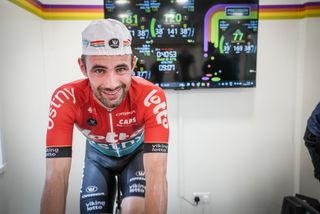
The pros pedalled with suplesse
Before me, Victor Campanearts and Jan Bakelants spun with suplesse on their turbo trainers, and just beyond them a wall of television screens displayed our vital stats: watts, heart rate, body temp. I was currently putting out a similar amount of absolute power as the Tour de France stage winners (always good to shoehorn in such sentences) but given I’m packing a little (a lot) more heft than them, my watts per kilo was only around half of their current output.
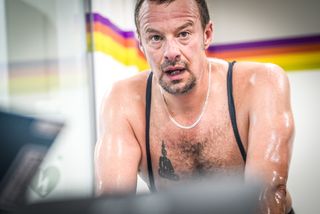
Steve felt like a Christmas turkey peering through the glazing of an oven
Rather than power though, it’s heart rate that perhaps decides how your body deals with the heat, and this was the barometer Dr Hunt was keeping a close eye on as we rode. If he noticed an HR spike he would reduce the power on the trainer. This was so the full 50 minute session could be completed in relative comfort while eliciting as much sweat and therefore heat adaptation as possible. It was truly terrifying how rapidly my heart rate increased with just the slightest change in riding position, or simply just taking a drink from a bidon.
It was closing in on 45 minutes of riding when I lost the ability to speak anything but gibberish. The heat chamber was winning. I looked at my watts on the screen behind Campanerts and Bakelants, who were each engaged in their own private skirmish with the searing temperature – at 170 watts, slap-bang in the middle of Zone 1, my heart rate was banging away at 165bpm (high Zone 3, low Zone 4 for me).
The results are in
With 50 minutes of turning pedals in what was beginning to feel like a tropical monsoon climate now complete, Dr Hunt opened the oven door and gave us a quick prod with the carving fork. We were cooked to perfection. It was time to look at the all important stats:

Whole-body sweat rate - 2.04 litres per hour (L/h)
Average power - 185W, 3.0 watts per kilo (W/kg)
Sweat sodium concentration - 957 milligrams of sodium per litre of sweat (mg/L). i.e. Moderately salty sweat

Whole-body sweat rate - 1.88 litres per hour (L/h)
Average power - 173W, 2.45 watts per kilo (W/kg)
Sweat sodium concentration - 1,044 milligrams of sodium per litre of sweat (mg/L). i.e. Moderately salty sweat

Whole-body sweat rate - 2.92 litres per hour (L/h)
Average power - 143W, 1.55 watts per kilo (W/kg)
Average heart rate - 143 beats per minute
Sweat sodium concentration - 1,024 milligrams of sodium per litre of sweat (mg/L) i.e. Moderately salty sweat
My suspicions were confirmed, at around three litres per hour – albeit in 40-degree heat – I’m truly amazing at sweating. But what are the reasons for this? Dr Hunt was on hand with the answers.
The takeaways

“Because you are well trained you can produce a decent power output on the bike: more power equals more heat and more heat means more sweat,” Dr Hunt began his summary – and I won't lie, I liked what I was hearing. Then he dropped the inevitable bombshell: ”You also have above average body mass. With more body mass comes more muscle mass and with more muscle mass comes more heat production and with more heat produced, comes more sweat produced.”
What I was able to extrapolate from his diplomatic analysis is that I must stop going to the gym and bulking up in the free weights section (which I never actually do). Or stop eating crisps (which I very much do) for a less sweaty cycling experience.
But apart from the obvious discomfort, is a high sweat rate detrimental to cycling performance?
“In general the upper limit of fluid intake we've seen is around 2 L/h, however for most individuals this rate of fluid ingestion needs to be trained, and in practice, most individuals have a lower limit (<1.5 L/h),” said Dr Hunt. “ And so attempting to consume over that volume of fluid is generally unsustainable.”
However, this isn’t to say that athletes with high sweat rates cannot be successful in hotter climates. For example, Luke Henderson took on 1,845ml fluid per hour over 9hrs 30mins at Ironman Worlds in Kona this year. But caution must be observed, and rather than testing the water yourself – so to speak – and in doing so risking gastrointestinal issues or even a potential electrolyte imbalance, Dr Hunt suggests a softly softly approach, preferably under the guidance of an expert. “Conducting body mass measurements and consulting with a sports scientist before making drastic changes to your hydration strategy may be the best approach for both safety and performance,” he said.
For me, personally? I don’t have any particular desire to ride anywhere hot, any time soon. So, I guess I’ll put my 100-mile ride in Riyadh on the back burner for now.

Thank you for reading 20 articles this month* Join now for unlimited access
Enjoy your first month for just £1 / $1 / €1
*Read 5 free articles per month without a subscription

Join now for unlimited access
Try first month for just £1 / $1 / €1
Steve has been writing (mainly fitness features) for Cycling Weekly for 11 years. His current riding inclination is to go long on gravel bikes... which melds nicely with a love of carbs
-
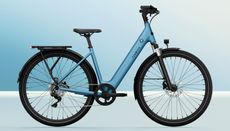 New Tenways CGO800 Plus city electric bike offers an energised urban ride
New Tenways CGO800 Plus city electric bike offers an energised urban rideEight speed gearing suits the Tenways CGO800 Plus electric bike to hillier city and leisure riding
By Cycling Weekly Published
-
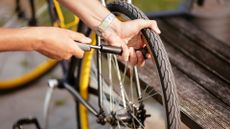 How to fix a puncture and patch a bicycle inner tube
How to fix a puncture and patch a bicycle inner tubeA step-by-step guide on how to fix a puncture
By Cat Glowinski Published